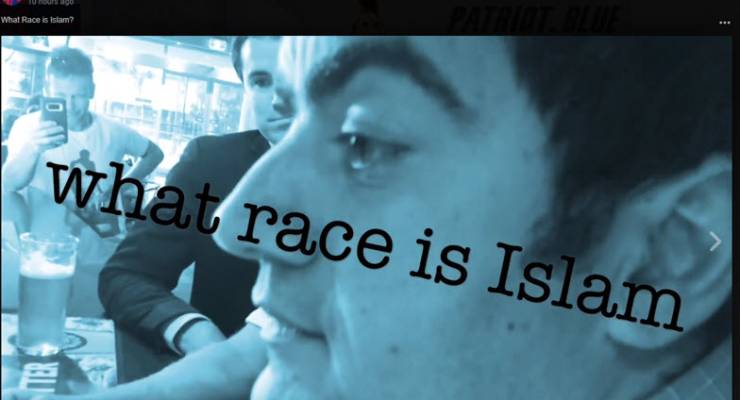
Screen capture from the Patriot Blue facebook page
The shaking mobile phone footage, posted to the Patriot Blue Facebook page, is shot by someone who clearly towers over their subject. Waiting at a bar in Melbourne, Senator Sam Dastyari is laughingly and pointedly asked by a group of men about his religious beliefs and the halal certification of the drinks he is ordering. He is called a terrorist and a monkey, told to return to Iran. The silence of the bar staff and most of Dastyari’s companions, as well as the angle of the footage, speaks to a lingering, unstated threat.
As it turns out, the situation remains contained. The only slam is a verbal one: Labor MP Tim Watts’ retort to the question “What race is Islam?” — “What race is dickhead?”
But what if it hadn’t? What if the situation had turned violent?
The question returns us to the punch that launched a thousand think pieces, interviews and panel discussions. As Donald Trump assumed the US presidency on January 20 this year, white supremacist figurehead Richard Spencer was being interviewed (by our very own ABC, as it happens) when a black-clad Antifa member screamed in from camera left (where else?) and planted a fist in Spencer’s face. It became rich fodder for lots of chin-stroking analysis, usually stemming from liberal discomfort about political violence across the media. It returns to our screens and pages with every flaring up of conflict between the hard right and their militant opponents.
The group who accosted Dastyari, Patriot Blue, have denied they are racists. That they are named after a neo-Nazi group in the film Romper Stomper tells its own story.
“Is it cool to punch Nazis?” is one of the questions leftist historian Mark Bray seeks to answer in his recent book Antifa: the anti-fascist handbook. The book is equal parts brisk, essay-style history of anti-fascist movements around the world, a how-to guide for aspiring activists, and an “unabashedly partisan call to arms” (the book is as much about equipping existing activists as it is convincing the sceptical).
Bray’s take on violence is that it is not as common a tactic as one one would believe — a “small but vital sliver”. However, the book opens with the Spanish anarchist Buenaventura Durruti (“Fascism is not to be debated, it is to be destroyed!”) and, as a quote from “Murray”, an activist in Baltimore, makes clear, there is nothing that isn’t ultimately justified in opposing Nazis:
“You fight them by writing letters and making phone calls so you don’t have to fight with fists. You fight them with fists so you don’t have to fight them with knives. You fight them with knives so you don’t have to fight them with guns. You fight them with guns so you don’t have to fight them with tanks.”
Later on, the book deals with interwoven issues of violent resistance and “No-platforming” — the two most controversial and illiberal tactics employed by anti-fascists — and divides arguments up by the answering the obvious oppositions:
Freedom of speech, the rule of law and the ‘marketplace of ideas’
“… antifascists make a historical argument based on the accurate observation that ‘rational debate’ and the institutions of government has failed to consistently halt the rise of facism. Given that fact, they argue that the only hope to prevent a sequel is to physically prevent any potential fascist advance …”
Aren’t you as bad as Nazis if you punch Nazis?
“… the first and most important point to make is that most anti-fascist organising is literal self-defense. What about when fascists do not pose an immediate physical threat? Is it better to ignore small ‘harmless’ fascist groups? By now it should be clear that small fascist groups do not always remain that way. In Greece, Golden Dawn burst out of nowhere to become a major force poised to lead a government before criminal charges decimated party leadership in 2013. And they may yet bounce back; we can never be sure.”
Don’t you just alienate possible allies and evoke sympathy for the Nazis?
“The spectacle of shutting down fascists may give them more attention in the short-term, but such actions deprives them of the ability to capitalise on that attention. Moreover, the spectacle of shutting them down, like all media spectacles, inevitably fades as it becomes more regular. The first time anti-fascists shut down Nazis it’s newsworthy, the fiftieth time not so much. Certainly, fascists always play the victim when they are shutdown. Yet, they also play the victim when they are not. Fascism was built on fear — fear of Jews, communists, immigrants, Freemasons, homosexuals, ‘national decadence,’ aesthetic modernism, ‘white genocide,’ and so on. No matter how the Left treats fascists, they will always present themselves as aggrieved victims.”
Sam Dastyari might never read Antifa’s advice on this matter, but as long as the threat of moments like this remain a low-level hum in public life, it’s a question we must confront.








Aren’t you as bad as Nazis if you punch Nazis? Yes! If we wish to have an enlightened, engaged, sophisticated society then going round punching people, even obvious dickheads and worse, isn’t going to achieve anything positive. Has “civilisation” learnt nothing??
I agree Bethany. Also, verbal violence should never be dismissed as insignificant. Violent or aggressive words have the potential to hurt just as much, sometimes even more, than physical violence.
I actually saw that argument being made at the Daily Sturmer… an odd coincidence*
*(but then so is the fact that I just used 14 words)
These guys pick their targets. On Wednesday night (Uni night), it is not uncommon to see 30 somethings prowling around in groups, bullying young blokes in their late teens, regardless of race. Do you think for a second they’d challenge a group of Lebanese fellas their same age, having a drink in a bar, who looked like having punch-up in a pub was part of the usual week night’s entertainment?
However, a very good friend of mine, caucasian male aged 32, was recently abused by a group of random blokes of middle eastern descent when leaving a nightclub in Sydney. They were making abusive comments, claiming his mother was a whore etc. He walked across the road and “sorted” it with the main protagonist. It cuts both ways.
none of those rednecks have any ticker, just whack the biggest and the rest run with their tails between their legs, huge mouths, tiny hearts even smaller brains, probably the love children of pauline and david oldfield, there`s a match made in heaven, if they were sheep straight to the meat works with them, no breeding potential there.
I’m with you Brian. Enlightened attitudes and debating skills counted for nought in the years leading up to WWII.
Violence gets violence. Sam went up in my estimation remaining cool and courageous in the face of ugly and stupid racism. He did a halal of a job.
You are right on the money, John … violence just leads to revenge and further violence … it is never justified in a civilised society …
*Sigh* How tiresome. Provocation hasn’t been a legal justification for violence for donkey’s years. The only acceptable form of violence is self-defence, and if you can’t tell the difference between the two you aren’t thinking hard enough. Not only would it have been wrong for Dastyari to commit a physical assault here, it would have greatly increased the risk of him being injured himself. Let’s do more to legislate (and enforce laws) against hate speech and protect those who are subjected to such disgusting verbal attacks, but can we stop buying into macho, infantile fantasies about the glory of punching for a good cause?
Well said.